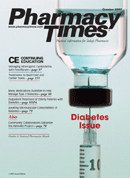Publication
Article
Pharmacy Times
Guidelines Recommend ACE Inhibitor or ARB for Heart Failure
Author(s):
Dr. Dutcher is a registered pharmacist based in Punta Gorda, Fla.
Angiotensin-converting enzyme (ACE) inhibitors and angiotensin receptor blockers (ARBs) are indicated for the treatment of hypertension, and certain agents in each class have been approved for heart failure (Table 1).1 The American Heart Association and the American College of Cardiology have updated their guidelines for the management of myocardial infarction (MI).2 The updates include the recommendation that all patients post MI receive an ACE inhibitor--or an ARB (valsartan [Diovan] or candesartan [Atacand]) if they are unable to tolerate an ACE inhibitor--if they have signs of heart failure or low ejection fraction (Table 2).
The Heart Failure Society of America (HFSA) also recommends that ACE inhibitors be prescribed to all patients with left ventricular systolic dysfunction.3 The HFSA recommends ARBs (valsartan or candesartan) as reasonable alternatives. The society recommends ACE inhibitors for the prevention of heart failure in asymptomatic patients with a decreased left ventricular ejection fraction <40% and in high-risk patients, including those with coronary artery disease, peripheral vascular disease, or stroke and those with diabetes who smoke or have microalbuminuria.
There is compelling evidence that ACE inhibitors should be used to inhibit the renin-angiotensin-aldosterone system in all heart failure patients with left ventricular systolic dysfunction. Several large clinical trials have demonstrated improvement in morbidity and mortality in heart failure patients with left ventricular dysfunction. ACE inhibitor dosing should be titrated to the dose used in clinical trials (Table 3).
Recently, Lee and colleagues reported the results of a meta-analysis of ARBs in heart failure and high-risk acute MI.4 Based on this analysis of 24 trials involving >30,000 patients, they found that ACE inhibitors and ARBs do not differ in their efficacy for reducing all-cause mortality and heart failure hospitalization in patients with these 2 conditions.
ARBs may be substituted in patients who cannot tolerate an ACE inhibitor due to cough, allergy, or angioedema. Patients intolerant to ACE inhibitors due to hyperkalemia or renal insufficiency are likely to experience the same side effects with an ARB.
ARBs are recommended for routine use in symptomatic and asymptomatic patients with a left ventricular ejection fraction <40% who cannot tolerate an ACE inhibitor for reasons other than renal insufficiency or hyperkalemia. Valsartan and candesartan can be considered initial therapy, preferred over an ACE inhibitor, for patients with the following conditions: heart failure post-MI and chronic heart failure.
Combination Therapy
Several studies have evaluated combination therapy on exercise tolerance and relief of symptoms in chronic heart failure patients. Hamroff and colleagues evaluated the effect of adding losartan (Cozaar) 50 mg daily in patients with severe heart failure being treated with maximal ACE inhibition.5 The losartan-treated group had significant improvement in exercise tolerance and alleviation of symptoms.
In the Randomized Evaluation of Strategies for Left Ventricular Dysfunction (RESOLVD) pilot study, heart failure patients were randomized to receive candesartan, candesartan plus enalapril (Vasotec), or enalapril for 43 weeks.6 There was a trend toward increased ejection fraction in the candesartan-plus-enalapril group. The investigators also concluded that most patients tolerated combination therapy.
The Valsartan Heart Failure Trial (Val-HeFT) studied whether there is a clinical benefit to adding valsartan to an ACE inhibitor in patients with heart failure.7 The findings showed no difference in all-cause mortality. Yet, there was a significant reduction in the combined end point of all-cause mortality and morbidity in the group receiving valsartan. The majority of the benefit of valsartan was observed in patients not receiving an ACE inhibitor or a ?-blocker. Another finding was that patients taking an ACE inhibitor plus an ARB plus a ?-blocker tended to have a negative outcome, but this result did not reach clinical significance.
Adherence and Dosing
ACE inhibitors and ARBs can be effective only if they are taken as directed by the physician and are prescribed at an appropriate dose (the target dose used in clinical trials). The degree to which patients with heart failure adhere to ACE-inhibitor or ARB therapy outside the context of clinical trials is not known. It is known, however, that nonadherence can lead to disease exacerbation or deterioration, hospital admissions, increased physician visits, and mortality.
A study by Newby and colleagues showed that long-term adherence to secondary prevention therapies for coronary artery disease (CAD) remains poor.8 Nearly 50% of the patients with CAD in a 7-year study admitted that they did not consistently take ACE inhibitors, ?-blockers, and lipid-lowering therapy or aspirin.
Equally important is the dosing of these agents. The Assessment of Treatment with Lisinopril And Survival (ATLAS) trial showed that treatment with higher doses of lisinopril (Prinivil, Zestril) reduced the combined end point of all-cause mortality and hospitalization for any reason by 12% relative to treatment with low doses.9 The investigators also concluded that high-dose ACE-inhibitor treatment of all US patients similar to those included in the ATLAS trial would save 100,000 lives, prevent 250,000 hospitalizations, and reduce costs by $2 billion annually.
Despite the benefits of proven therapy for heart failure, mortality remains high. ACE inhibitors and ARBs have been shown to decrease mortality. Yet, adherence to and dosing of ACE inhibitors and ARBs can have a significant impact on morbidity and mortality. Heart failure patients need to be coached regarding adherence to medications, and physicians need to be reminded to titrate ACE-inhibitor and ARB doses to the target doses that were used in clinical trials.
Chemotherapy-induced Nausea and Vomiting (CINV)
CINV is a troublesome problem for patients in hospitals. This table is adapted from the February 2007 issue of INSIDE PMB, the newsletter of the National Cancer Institute's Pharmaceutical Management Branch. It also is available at http://ctep.cancer.gov/about/insidepmb.html.
Pathophysiology
Chemotherapy induces nausea and vomiting by activating 1 or more of the following mechanisms:
? Direct or indirect stimulation of the chemoreceptor trigger zone (CTZ); the CTZ, located in the floor of the fourth ventricle outside of the blood-brain barrier, is responsible for most CINV
? Peripheral stimulation of the vagus nerve in the gastrointestinal tract
? Vestibular mechanisms
? Cortical mechanisms
? Taste and smell alterations
Mechanism of Action (MOA)
The exact MOA is unknown. It is postulated that the vomiting center is triggered by various neurotransmitters released by CTZ activation. Some major neurotransmitters responsible for CINV include dopamine, serotonin, histamine, norepinephrine, and substance P. The role of other enzymes such as monoamine oxidase, cholinesterase, and catecholamine located around the CTZ is poorly understood in CINV.
Signs and Symptoms
Nausea, vomiting, dehydration, imbalanced electrolytes, weight loss, and slow-healing wounds
Onset and Duration
? Acute: within a few minutes to several hr following therapy and lasting up to 6 hr
? Delayed: usually >24 hr post chemotherapy lasting up to 7 days
? Anticipatory: a conditioned response affecting people with prior experiences with severe CINV. It can occur before, during, or after chemotherapy administration.
Patients with Risk Factors
Patients undergoing chemotherapy treatment; people with histories of motion sickness or morning sickness during pregnancy; patients at a younger age; nondrinkers
Treatment
Prevention is based on the emesis risk of the chemotherapy administered. Acute and delayed emesis is classified into 4 categories: high, moderate, low, and minimal. Examples are as follows:
? Acute high-risk CINV is usually treated with a 5-hydroxytryptamine 3 -receptor antagonist (5-HT3RA) plus a corticosteroid on day 1
? Delayed high-risk CINV might be treated with dexamethasone plus a 5-HT3 RA and a dopamine antagonist on days 2 to 4
? Anticipatory CINV may be treated with benzodiazepine plus antiemetic agents before and during chemotherapy; techniques in relaxation, desensitization, and hypnosis can be effective
Additional treatment information can be found in the National Comprehensive Cancer Network Guidelines-Emesis, or in DeVita VT Jr, Hellman S, Rosenberg SA, Cancer: Principles and Practice of Oncology, 7th ed. Philadelphia, Pa: Lippincott Williams & Wilkins; 2005.
References:
1. Drug Facts and Comparisons. 61st ed. Wolters Kluwer Health; 2007:504c-517c.
2. ACC/AHA 2005 Guideline Update for the Diagnosis and Management of Chronic Heart Failure in the Adult. Available at: http://circ.ahajournals.org/cgi/content/full/112/12/e154. 3. HFSA Comprehensive Heart Failure Practice Guidelines 2006. Available at: www.heartfailureguideline.org.
4. Lee VC, Rhew DC, Dylan M, et al. Meta analysis: Angiotensin receptor blockers in chronic heart failure and high risk acute myocardial infarction. Ann Intern Med. 2004;141:693-704.
5. Hamroff G, Katz SD, Mancini D, et al. Addition of angiotensin II receptor blockade to maximal angiotensin-converting enzyme inhibition improves exercise capacity in patients with severe congestive heart failure. Circulation. 1999;99:990-992.
6. McKelvie RS, Yusuf S, Pericak D, et al. Comparison of candesartan, enalapril, and their combination in congestive heart failure: Randomized Evaluation of Strategies for Left Ventricular Dysfunction (RESOLVD) pilot study. The RESOLVD pilot study investigators. Circulation. 1999;100:1056-1064.
7. Cohn JN, Tognoni G, Glazer RD, et al. Rationale and design of the Valsartan Heart Failure Trial: a large multinational trial to assess the effects of valsartan, an angiotensin-receptor blocker, on morbidity and mortality in chronic congestive heart failure. J Card Fail. 1999;5:155-160.
8. Newby LK, Allen LaPointe NM, Chen AY, et al. Long-term adherence to evidence-based secondary prevention in coronary artery disease. Circulation. 2006;113:203-212.
9. Assessment of Treatment with Lisinopril and Survival (ATLAS): High dose of ACE inhibitors better than low. Available at: www.medscape.com/viewarticle/433554.
10. Yusuf S, Sleight P, Pogue J, Bosch J, Davies R, Dagenais G. Effects of an angiotensin-converting-enzyme inhibitor, ramipril, on cardiovascular events in high-risk patients. The Heart Outcomes Prevention Evaluation (HOPE) Study Investigators. N Engl J Med. 2000;342:145-153.
11. Kober L, Torp-Pedersen C, Carlsen JE, et al. A clinical trial of the angiotensin-converting-enzyme inhibitor trandolapril in patients with left ventricular dysfunction after myocardial infarction. N Engl J Med. 1995;333:1670-1676.
12. GISSI-3 Study Group. GISSI-3: effects of lisinopril and transdermal glyceryl trinitrate singly and together on 6-week mortality in patients with acute myocardial infarction. Gruppo Italiano per lo Studio della Soprawivenza nell'Infarto Miocardico. Lancet. 1994;343:1115-1122.
13. Packer M, Poole-Wilson PA, Armstrong PW, et al. Comparative effects of low and high doses of the angiotensin-converting-enzyme inhibitor, lisinopril, on morbidity and mortality in chronic heart failure. Circulation. 1999;100:2312-2318.
14. The EURopean trial On reduction of cardiac events with Perindopril in stable coronary Artery disease investigators. Efficacy of perindopril in reduction of cardiovascular events among patients with stable coronary artery disease: randomized double-blind, placebo-controlled, multicentre trial (the EUROPA study). Lancet. 2003;362:782-788.
15. Swedberg K, Held P, Kjekshus J, Rasmussen K, Ryden L, Wedel H. Effects of the early administration of enalapril on mortality in patients with acute myocardial infarction. Results of the Cooperative North Scandinavian Enalapril Survival Study II (CONSENSUS II). N Engl J Med. 1992; 327:678-684.
16. Pfeffer MA, Braunwald E, Moye LA, et al. Effect of captopril on mortality and morbidity in patients with left ventricular dysfunction and myocardial infarction. Results of the Survival And Ventricular Enlargement trial. The SAVE investigators. N Eng J Med. 1992;327:669-677.
17. Pfeffer MA, McMurray JJ, Velazquez EJ, et al. Valsartan in Acute Myocardial Infarction Trial (VALIANT) Investigators. Valsartan, captopril, or both in myocardial infarction complicated by heart failure, left ventricular dysfunction, or both. N Engl J Med. 2003;349:1893-1906.
18. Young J, Swedberg K, Dunlap ME, et al. Substantial reduction in all-cause mortality and morbidity with candesartan in patients with chronic heart failure and systolic left ventricular dysfunction. Results of the CHARM low EF trials. Eur Heart J. 2004;25(suppl):487.
19. Effects of enalapril on mortality in severe congestive heart failure. Results of the Cooperative North Scandinavian Enalapril Survival Study (CONSENSUS). The CONSENSUS Trial Study Group. N Eng J Med.1987;316:1429-1435.
20. Cohn JN, Johnson G, Ziesche S, et al. A comparison of enalapril with hydralazine-isosorbide dinitrate in the treatment of congestive heart failure. N Engl J Med. 1991;325:303-310.
21. Konstam MA, Rousseau MF, Kronenberg MW, et al. Effects of the angiotensin converting enzyme inhibitor enalapril on the long-term progression of left ventricular dysfunction in patients with heart failure. SOLVD Investigators. Circulation. 1992;86:431-438.










